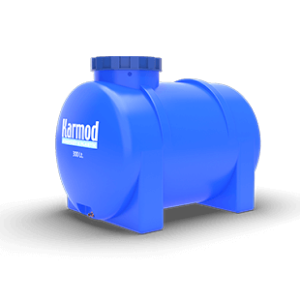A rainwater tank is a storage tank used for collecting, storing, and reusing rainwater. These tanks are used to prevent water wastage and promote the efficient use of water resources. Polyethylene water tanks are commonly used in these systems. Rainwater tanks are set up to collect raindrops from the roofs or gutters of homes or businesses. A rainwater tank is an economical and environmentally friendly option for those who want to save water.
What are the features of rainwater tanks?
Rainwater tanks are storage products made using polyethylene. Polyethylene rainwater tanks have certain features and advantages. One of the main advantages is that it is a waterproof and airtight material. Polyethylene is a waterproof and airtight material, so it prevents rainwater from deteriorating and air from entering, making the water more sterile. In addition, it is a very durable material. Polyethylene is a strong and flexible material that is suitable for long-term use.
Another feature is the variety of sizes available. Tanks made from polyethylene can be produced in different capacities, ranging from a few hundred liters to thousands of liters, depending on the volume of rain in the area where people live. In addition to size variety, it also provides ease of use. Designed for easy installation and water discharge. One of the most important advantages is that it has a very affordable price tag compared to other storage products. The price of storage is affordable because polyethylene is a cheap material. Also, it has a high UV resistance. Tanks made of polyethylene are resistant to UV light, making them suitable for long-term use.
These features indicate that rainwater storage tanks made from polyethylene are a popular and affordable choice. Additionally, a filtration system can be installed to achieve a cleaner use. There is a filtration system in these storage tanks that preserves the quality of storage and keeps the water clean. The water collected in tanks with these systems can be drinkable. There is a control system, usually a float, to monitor the level of storage and the quality of the water. These features enable efficient and safe use of rainwater storage tanks.
How to Install Rainwater Collection Systems?
Rainwater collection systems are designed to transport rainwater to a designated area in a house or building. Generally, rainwater collection systems work with specific steps. The first step is when rainwater is collected from a roof or another surface via rainwater pipes and transferred to a tank. Once the tank is filled with water, it is cleaned by a filter to make it suitable for use in the house. This helps to make it suitable for home use. Then, with the help of a pump or hydrophore, the filtered rainwater is pumped to the designated location. Finally, rainwater can be used for water conservation, garden irrigation, etc. These steps illustrate the general principles of rainwater collection systems. The installation of a rainwater collection system consists of the following steps:
Planning
Firstly, you need to determine the area where you want to install the rainwater collection system and your requirements. This will enable you to identify the necessary materials and equipment.
Collecting the Required Materials and Equipment
The necessary materials, equipment, and tools for the rainwater collection system should be gathered correctly. These materials may include rainwater pipes, rainwater tanks, water pumps, filters, pipe connectors, etc.
Placement of the Tank
There are various storage products available for use in rainwater systems, but these storage products are usually vertical plastic water tanks. These tanks are highly compatible with the designs and advantages provided by their raw materials. Moreover, they are an affordable solution. We have a separate section describing the features of these storage products.
Installation of the Pipes
Rainwater pipes should be extended from the tank or rain gutter to the designated location of the house or building. The pipes should be connected to each other using appropriate connectors.
Installation of the Filter and Water Pump
Rainwater should be pumped into the tank through the filter before it is cleaned. Therefore, the filter and water pump should be installed near the tank in the correct way. The filtering process is important in many ways.
Testing the System
After the installation is complete, the system should be turned on, and the rainwater collection system should be checked to ensure it is working properly. This is the final step in the installation of the rainwater collection system. However, since each situation and structure is different, it is recommended to obtain professional support for the complete installation of the system.
What is the Importance of Rainwater Harvesting Systems for Our World?
Although not widely used, rainwater harvesting systems are important for the world for several reasons. One of the most important reasons is water conservation. We need to save water in all areas of our lives. Rainwater harvesting systems provide alternative water sources for homes and buildings, helping to conserve and efficiently use permanent water sources.
Rainwater harvesting systems prevent the destruction of natural ways of rainwater and reduce soil erosion. Additionally, these systems reduce the energy requirement for water used in homes and buildings, leading to energy savings. They also reduce the costs of water-dependent projects and facilitate access to water. These projects are often found in agricultural areas.
In recent times, these systems have contributed to the climate change debate. They help prevent water scarcity caused by climate change and put less pressure on water sources. For these reasons, rainwater harvesting systems provide an important and efficient water source for the world.


 EN
EN
 DE
DE
 FR
FR
 IT
IT
 ES
ES
 PT
PT
 RU
RU
 AR
AR
 BG
BG
 SR
SR
 GR
GR
 SQ
SQ
 RO
RO
 PL
PL
 HU
HU
 CZ
CZ
 HR
HR
 AZ
AZ
 GE
GE
 AM
AM
 IL
IL
